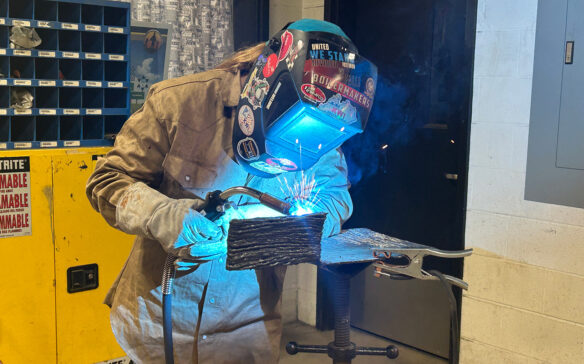
A student learns how to weld in one of Fleming County’s career and technical education pathways. The district is one of Kentucky’s leading innovative districts in the area of assessment and accountability and a member of the first Local Laboratories of Learning (L3) cohort. Submitted photo
For the past seven years, the Fleming County School District has been working to create an accountability and assessment system that fits their students.
Because the district has different types of learners, Michelle Hunt, Fleming County chief academic officer, said the district wanted to make sure their students were seen as more than just their test scores.
“We wanted to get unshackled from the standardized assessment shoreline that we felt wasn’t an accurate measure of everything a student can do,” said Hunt.
Fleming County is one of Kentucky’s leading innovative districts in the area of assessment and accountability. Fleming County serves approximately 2,200 students spread across a largely rural area in eastern Kentucky.
The Kentucky Department of Education (KDE), the Center for Innovation in Education (C!E), and the Kentucky Board of Education have partnered together to establish three cohorts of Local Laboratories of Learning (L3) that are involved in the design of a new assessment and accountability system and pilot any newly created systems.
Fleming County shifted its focus from state assessment achievement to one focused primarily on the growth of students. Hunt said this has led to thinking about school accountability in a radically different way.
“I think students appreciate the voice and choice that is afforded to them, especially K-12 because we do things that allow kids to have opportunities to explore their interests and their passions,” said Hunt.
The L3s have three transformative goals:
- Redefine school success in a reciprocal partnership with communities;
- Create tangible shifts in policy, mindsets, and habits throughout the system; and
- Develop new ways of seeing the truth about communities, students and schools.
As a part of the first cohort, Fleming County’s local accountability model focused on student groups to find out what mattered the most to them and incorporated student and community feedback.
“One of the things that the L3s has helped us with is reciprocity,” said Hunt. “That whole process and community involvement, it has allowed us to really slow down and do the empathy interviews and make sure that we are creating a system for all learners and not a pocket of learners.”
In early 2022, the district created an accountability model referred to as Measures of Quality. The district has since created a new local accountability model and revised it three different times, incorporating what they call bridge performance indicators (BPIs). The BPIs measure student progress toward the district’s six competencies, which were created from conversations with staff, students and community stakeholders and were then assessed by members at the district level.
The six competencies are teamwork, communication, problem-solving, service, innovation and creativity, and growth and achievement (a life of learning and adaptability).
“We are trying to develop a well-rounded individual student who can be competitive in the world of artificial intelligence and the world of global competitiveness through lots of online jobs,” said Hunt. “We support them through the BPI work and through the graduate work to make sure our students are ready because they will become the face of Fleming County High School when they go out into our community.”
As part of this accountability system, students create a website to demonstrate progress towards the BPIs, which the district said allows students to focus on a piece of work that they are most proud of that demonstrates their knowledge in each of the competencies.
The students use their unique websites to show and display their work and skillsets achieved both inside and outside of the classroom. Eventually, high school students can use these websites as their resumes to attain internships or other opportunities within the community.
“I think we did a fairly good job before L3s as far as really interviewing and surveying students, but I think with the L3s and their support, we have been more intentional on making sure that our marginalized groups are heard,” said Hunt.
She said that this approach has shown students learn best when they are actively involved in shaping their learning experiences based on their interests and goals. In addition to encouraging educators to be creative with their instruction. One example Hunt said may be taking students who participate in the welding Career and Technical Education pathway who are also in a language arts class and intertwining the two curriculums to meet the requirements for each course and keep the student’s involvement high.
“The connection piece with the community business owners and the students starting to see how these ideas fit together, work together and where we are going is so important,” said Hunt. “I think if anything we fall short in educating the parents on what we are trying to do and showing them, it is much bigger than a website or a poster on a wall.”
Hunt said with the help of grant funding, the district has been able to provide professional development and learning opportunities for their administration and educators to help expand their knowledge and resources for these accountability systems.
“The L3s helped us with those growths and has connected us with other districts to almost be like a sounding board and given us ideas to think about different ways to approach things,” said Hunt.
Fleming County is just one of the 18 school districts involved in the L3 initiative. Schools looking for more information about the L3, Portrait of a Learner and United We Learn can find resources within the Kentucky Innovation Guide.



Leave A Comment